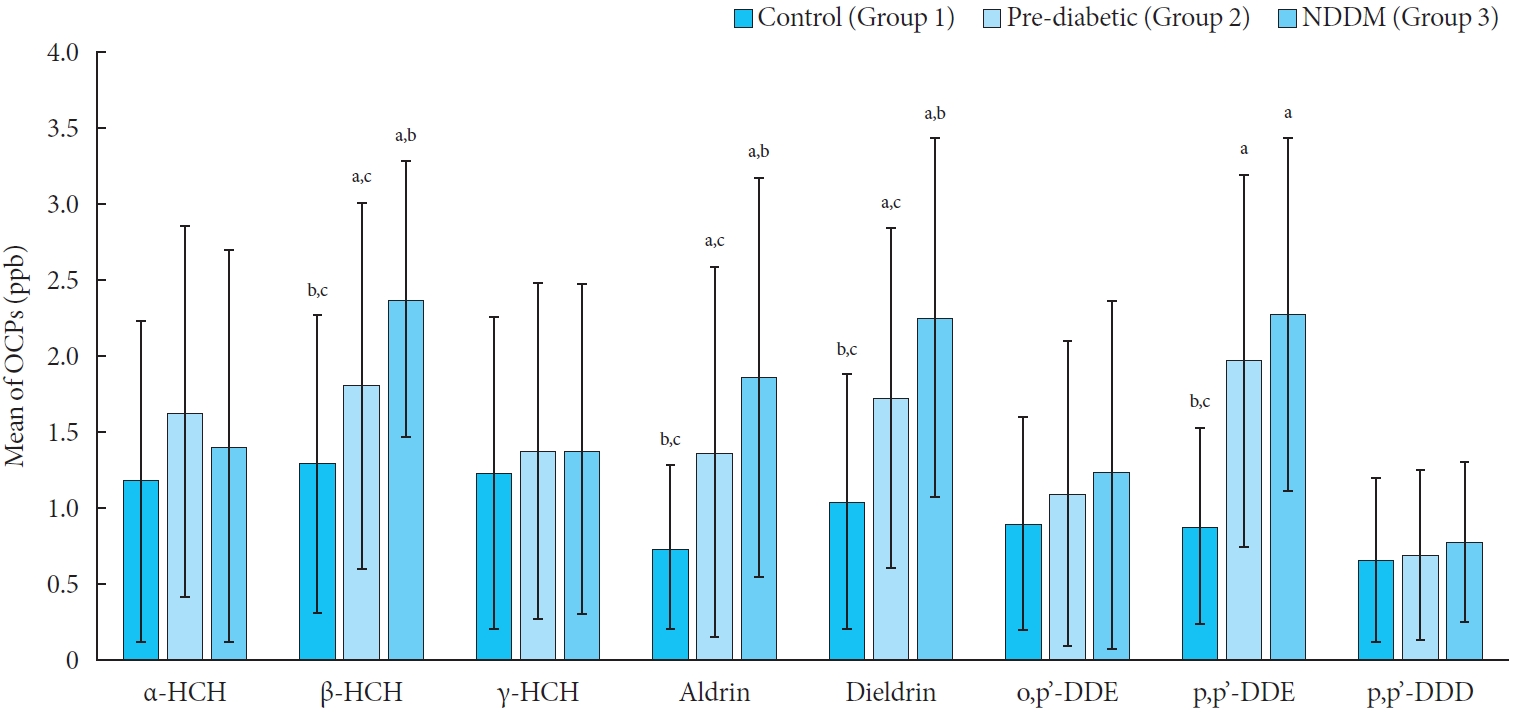
- Current
- Browse
- Collections
-
For contributors
- For Authors
- Instructions to authors
- Article processing charge
- e-submission
- For Reviewers
- Instructions for reviewers
- How to become a reviewer
- Best reviewers
- For Readers
- Readership
- Subscription
- Permission guidelines
- About
- Editorial policy
Search
- Page Path
- HOME > Search
Original Article
- Metabolic Risk/Epidemiology
- Level of Organochlorine Pesticide in Prediabetic and Newly Diagnosed Diabetes Mellitus Patients with Varying Degree of Glucose Intolerance and Insulin Resistance among North Indian Population
- Shipra Tyagi, Brijesh Kumar Mishra, Tusha Sharma, Neha Tawar, Abdul Jamil Urfi, Basu Dev Banerjee, Sri Venkata Madhu
- Diabetes Metab J. 2021;45(4):558-568. Published online January 15, 2021
- DOI: https://doi.org/10.4093/dmj.2020.0093

- 4,877 View
- 143 Download
- 10 Web of Science
- 10 Crossref
-
 Abstract
Abstract
 PDF
PDF Supplementary Material
Supplementary Material PubReader
PubReader  ePub
ePub - Background
Organochlorine pesticides (OCPs) exposure may induce an endocrine disruption which may lead to the risk of developing diabetes through alteration and disturbance of glucose metabolism, insulin resistance, and destruction of β-cells. The present study determines the recent trend of OCPs residue in blood samples and their association with the known risk factors responsible for developing the risk of diabetes among the North Indian population.
Methods
Blood sample of 300 patients (100 each of normal glucose tolerance [NGT], prediabetes and newly detected diabetes mellitus [DM]) between the age group of 30 to 70 years were collected. OCPs residue in whole blood samples was analyzed by using gas chromatography equipped with a 63Ni selective electron capture detector.
Results
Significantly higher levels of β-hexachlorocyclohexane (HCH), dieldrin, and p,p’-dichloro-diphenyl-dichloroethylene (DDE) were found in the prediabetes and newly detected DM groups as compared to NGT group. Insulin resistance showed to be significantly positive correlation with β-HCH and dieldrin. Also, fasting and postprandial glucose levels were significantly positively correlated with levels of β-HCH, dieldrin, and p,p’-DDE. Further, when OCPs level was adjusted for age and body mass index (BMI), it was found that β-HCH, dieldrin, and p,p’-DDE levels in blood increases the risk of diabetes by 2.70, 2.83, and 2.55 times respectively. Moreover, when we adjust OCPs level based on BMI categories (BMI <23, ≥23, and ≤25, and >25 kg/m2); β-HCH and p,p’-DDE showed a significant risk of developing newly detected DM with BMI >25 and ≥23 and ≤25 kg/m2.
Conclusion
The OCPs level present in the environment may be responsible for biological, metabolic, and endocrine disruptions within the human body which may increase the risk of developing newly detected DM. Hence, OCPs exposure can play a crucial role in the etiology of diabetes. -
Citations
Citations to this article as recorded by- Combined effects of organochlorine pesticides on type 2 diabetes mellitus: Insights from endocrine disrupting effects of hormones
Jiayu Shi, Dandan Wei, Cuicui Ma, Jintian Geng, Mengzhen Zhao, Jian Hou, Wenqian Huo, Tao Jing, Chongjian Wang, Zhenxing Mao
Environmental Pollution.2024; 341: 122867. CrossRef - Associations of chronic exposure to a mixture of pesticides and type 2 diabetes mellitus in a Chinese elderly population
Tian Chen, Xiaohua Liu, Jianghua Zhang, Lulu Wang, Jin Su, Tao Jing, Ping Xiao
Chemosphere.2024; 351: 141194. CrossRef - Application of In Vitro Models for Studying the Mechanisms Underlying the Obesogenic Action of Endocrine-Disrupting Chemicals (EDCs) as Food Contaminants—A Review
Monika Kowalczyk, Jakub P. Piwowarski, Artur Wardaszka, Paulina Średnicka, Michał Wójcicki, Edyta Juszczuk-Kubiak
International Journal of Molecular Sciences.2023; 24(2): 1083. CrossRef - The diabetogenic effects of pesticides: Evidence based on epidemiological and toxicological studies
Yile Wei, Linping Wang, Jing Liu
Environmental Pollution.2023; 331: 121927. CrossRef - Pesticides and insulin resistance-related metabolic diseases: Evidences and mechanisms
Ali Arab, Sara Mostafalou
Pesticide Biochemistry and Physiology.2023; 195: 105521. CrossRef - Circulating organochlorine pesticide levels, genetic predisposition and the risk of incident type 2 diabetes
Chengyong Jia, Shiyang Zhang, Xu Cheng, Peiwen Li, Jun An, Xin Zhang, Wending Li, Yali Xu, Handong Yang, Tao Jing, Huan Guo, Meian He
Environmental Pollution.2023; 337: 122541. CrossRef - Targets for pollutants in rat and human pancreatic beta-cells: The effect of prolonged exposure to sub-lethal concentrations of hexachlorocyclohexane isomers on the expression of function- and survival-related proteins
Nela Pavlíková, Jan Šrámek, Martin Jaček, Jan Kovář, Vlasta Němcová
Environmental Toxicology and Pharmacology.2023; 104: 104299. CrossRef - Association of Organochlorine Pesticides With Genetic Markers of Endoplasmic Reticulum Stress in Type 2 Diabetes Mellitus: A Case–Control Study Among the North-Indian Population
Neha Tawar, Basu Dev Banerjee, Sri Venkata Madhu, Vivek Agrawal, Sanjay Gupta
Frontiers in Endocrinology.2022;[Epub] CrossRef - Acaricidal and insecticidal efficacy of new esters derivatives of a natural coumarin osthole
Xijie Shan, Min Lv, Jingru Wang, Yujia Qin, Hui Xu
Industrial Crops and Products.2022; 182: 114855. CrossRef - Association between organochlorine pesticides and nonalcoholic fatty liver disease in the National Health and Nutrition Examination Survey 2003–2004
Hyunji Sang, Kyu-Na Lee, Chang Hee Jung, Kyungdo Han, Eun Hee Koh
Scientific Reports.2022;[Epub] CrossRef
- Combined effects of organochlorine pesticides on type 2 diabetes mellitus: Insights from endocrine disrupting effects of hormones

 KDA
KDA
 First
First Prev
Prev





